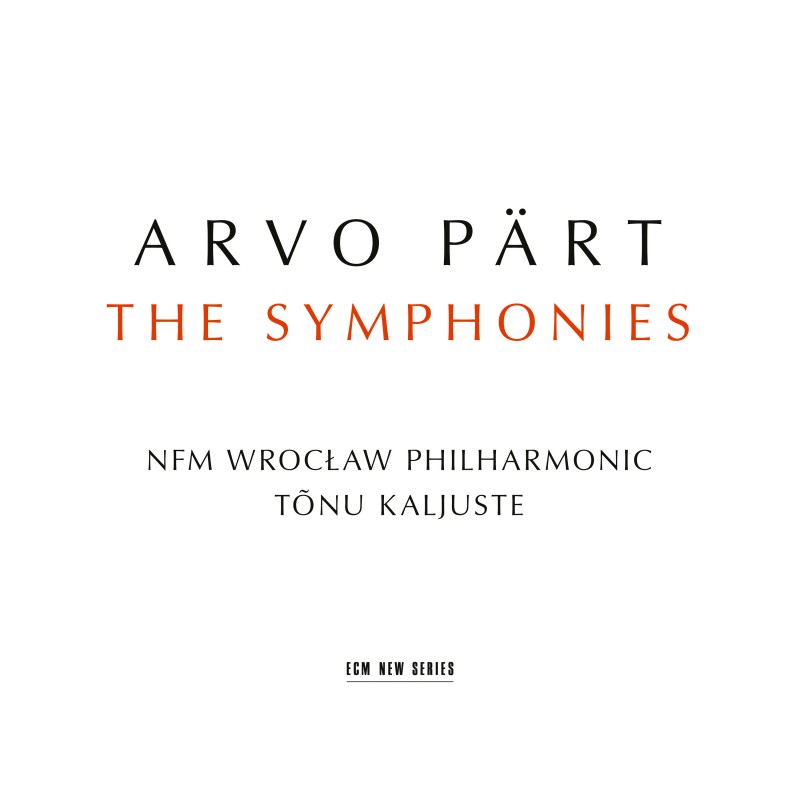PÄRT The Symphonies (Kaljuste)
View record and artist detailsRecord and Artist Details
Composer or Director: Arvo Pärt
Genre:
Orchestral
Label: ECM New Series
Magazine Review Date: 09/2018
Media Format: CD or Download
Media Runtime: 79
Mastering:
DDD
Catalogue Number: 481 6802

Tracks:
| Composition | Artist Credit |
|---|---|
| Symphony No. 1, 'Polyphonic' |
Arvo Pärt, Composer
Arvo Pärt, Composer Tõnu Kaljuste, Conductor Wroclaw Philharmonic Orchestra |
| Symphony No. 2 |
Arvo Pärt, Composer
Arvo Pärt, Composer Tõnu Kaljuste, Conductor Wroclaw Philharmonic Orchestra |
| Symphony No. 3 |
Arvo Pärt, Composer
Arvo Pärt, Composer Tõnu Kaljuste, Conductor Wroclaw Philharmonic Orchestra |
| Symphony No 4 |
Arvo Pärt, Composer
Arvo Pärt, Composer Tõnu Kaljuste, Conductor Wroclaw Philharmonic Orchestra |
Author: Pwyll ap Siôn
This struggle is first set out in the experimental, exploratory Symphony No 1. Written towards the end of Pärt’s studies at the Tallinn State Conservatory with Heino Eller, the composer is seemingly caught between the need to pay lip service to the avant-garde (in the form of chromaticism and atonality) and his desire to dig deep into the musical past for answers. It’s an uneasy dichotomy that drives much of Pärt’s music from the 1960s. Whereas the past is represented through canons, passacaglias, preludes and fugues in the Symphony No 1, it appears in the form of a simple quotation towards the end of the Symphony No 2. An edgier, more pointillistic sound world is presented at the beginning of the work, however, which soon gets caught up in dense, saturated, chromatic clouds of sound that push the music ever closer towards atonal atrophy and fragmentation. Salvation arrives unexpectedly in the form of the aforementioned quote from Tchaikovsky’s Album for the Young – a desperate clinging-on to lost innocence among the chaos. It’s a moment just as unsettling as Pärt’s use of JS Bach’s C major Prelude in his Credo two years later.
Composed in 1971, the Symphony No 3’s more openly tonal style draws it closer to the more recognisable sound world of No 4, some 35 years later. Subtitled Los Angeles, the Fourth adopts a method used in other instrumental works whereby Pärt sets a sacred song with the words omitted – the hidden text providing both structural stability and emotional sustenance. There’s also a degree of tension here not always encountered in Pärt that imparts a stronger sense of the ‘symphonic’ to the music.
The Fourth’s large-scale architectural dimensions are perfectly shaped and proportioned in the NFM Wrocaw Philharmonic’s performance under Tõnu Kaljuste, which does not suffer the curse of quiet music recorded live in a packed and highly resonant concert hall, as was the case with Esa-Pekka Salonen and the Los Angeles Philharmonic (ECM, A/10). Perhaps, as in Pärt’s set of symphonies, the journey is more interesting than the destination itself.
Discover the world's largest classical music catalogue with Presto Music.

Gramophone Digital Club
- Digital Edition
- Digital Archive
- Reviews Database
- Full website access
From £8.75 / month
Subscribe
Gramophone Full Club
- Print Edition
- Digital Edition
- Digital Archive
- Reviews Database
- Full website access
From £11.00 / month
Subscribe
If you are a library, university or other organisation that would be interested in an institutional subscription to Gramophone please click here for further information.




